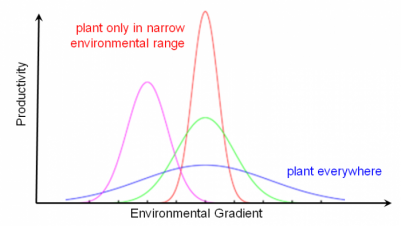3. Adaptation and Forest Management

How is adaptation relevant for forest management? There are some obvious implications. If we choose planting stock that is well adapted to local growing conditions, our forests will be healthy and productive. The use of planting stock that lacks important adaptive traits may lead to immediate or long-term problems. Trees that are stressed because of mal-adaptation have suboptimal productivity and tend to be vulnerable to insect pests and diseases. Sometimes these problems only become apparent after many years. For example, an exotic species from Norway that we plant in Alberta may grow very well for many years until an infrequent drought or cold event that never occurs in its home range causes major damage to trees or loss of the entire plantation.
If we want to optimize forest productivity and health, there are also more subtle considerations in choosing well adapted species, varieties, or genotypes. For this, we need to understand another concept: phenotypic plasticity. Phenotypic plasticity is the ability of a tree to adapt to different environmental conditions by changing its morphological or physiological characteristics (without a genetic change through evolution). For example, if nutrient conditions are poor, a tree may adapt by allocating more resources to root growth. If trees are exposed to drought condition, they may adapt by changing leaf size and thickness or by altering physiological pathways that result in higher water use efficiency. This ability to adapt through phenotypic plasticity is more important for trees than any other organism, because they cannot move away from damaging environments and have to be able to handle environmental variability throughout a long lifetime.

We can think of phenotypic plasticity as an adaptive trait itself. Species or populations that are subjected to strong environmental variability may evolve a high degree of phenotypic plasticity and become generalists. Species or populations that experience very stable environments may evolve very narrow environmental tolerances and become specialists. Often, there is a tradeoff between the ability to tolerate a wide range of environments and optimal fitness and productivity in a narrow environmental niche. The blue line represents a tree that is a “Jack of all trades, but master of none”. The red line represents a tree that is doing very well in one particular environment but is useless beyond its narrow range of specialization. In genetic resource management, we try to select genotypes that are productive as well as widely adapted for reforestation. Alternatively, we can optimize productivity of more narrowly adapted planting stock by matching them to the environment where they do best. The next section explains how.